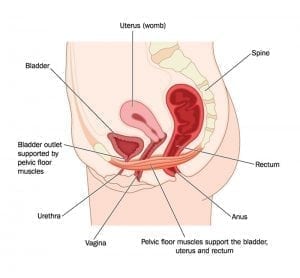Pelvic floor dysfunction can be a scary diagnosis if you are concerned for your fertility, but the good news is that it’s treatable and doesn’t seem connected to infertility.
When you feel a sneeze coming on, do you cross your legs so you don’t pee? Do you experience pain during sex that your doctor can’t find a reason for? Have you ever thought you had a urinary tract infection only to have all the tests come back clear?
If you’ve said yes to any of these, you might be experiencing pelvic floor dysfunction. It’s estimated that nearly one in three women will have this condition in her lifetime, and although that’s a high number, it’s still frequently misdiagnosed.
Healthcare providers are only now beginning to talk about the effects of losing control of the pelvic floor. Even if you’ve never experienced these symptoms, you should be aware so that you can take control of your sexual health, pregnancies, and quality of life.
What is PFD?
PFD is a problem with the muscles, ligaments, and tissues that form a sling-shape and support organs in your pelvis. This is your bladder, rectum, uterus and vagina. Symptoms include incontinence, difficulty or pain during sex or orgasm and unexplained pain in the pelvic region. In more severe cases, women also experience what feels like a bulge in the vagina or rectum, which indicates a prolapse of some kind.
Most symptoms fall into three cause types: weakness, spasm or impairment in coordination. These symptoms can all be addressed with treatments.
What causes PFD?

While aging is part of the list, PFD is not considered a normal or acceptable part of the aging process.
What can I do about it?
For many women, physical therapy makes a big difference in their cases of PFD. Nearly 75 percent of women saw a difference in their pelvic control by visiting a pelvic therapist and participating in exercises that strengthened and brought awareness to that area.
The therapist can also identify exercises for surrounding muscle groups that support the connections with the pelvic floor. Patients can also use biofeedback techniques to increase control and awareness of muscle groups.
For women who need more than physical therapy, there are also several different options. You can use a pessary device to help support the organs in the pelvic region. For spasms, botox injections can relieve symptoms. There are also surgeries to help correct severe PFD issues.
Can it affect my fertility?
The good-ish news is that no direct connection between PFD and infertility has been found to date. There are correlations between the two, as women with certain conditions are more likely to be experiencing PFD, and those conditions can also contribute to infertility.
For example, a recent study showed that women with polycystic ovarian syndrome had higher instances of PFD, but infertility issues are a result of PCOS rather than PFD, likewise with women experiencing endometriosis.
If you are experiencing pain or other PFD symptoms and are thinking of becoming pregnant, it’s a good idea to have a comprehensive physical exam to identify any conditions that might be affecting your fertility.
If it turns out that you are also experiencing PFD, correcting the issue as you explore your pregnancy options only aids in your overall sexual health as you become pregnant and subsequently deliver.




